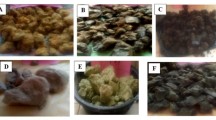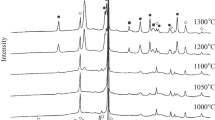Abstract
This study aims to characterize the clayey materials from the site of Mzouda in the Marrakech area, one of the largest producers and suppliers of tajines in Morocco. This traditional production is only based on empirical knowledge of artisans, causing some flaws, such as cracking under the effect of thermal shocks. The physical, chemical and mineralogical characterization of the starting clayey material will improve understanding of the thermal shocks resistance character of Mzouda tajine. The physical properties of raw materials were identified by particle size distribution and consistency limits. Chemical composition was evaluated through XRF, total organic content and calcimetry, while mineralogical characteristics were investigated by the XRD technique. Two common raw clay materials used for Tajine’s manufacturing in Morocco were chosen as references. Results showed that the main oxides in the studied samples were SiO2 and Al2O3, whereas the other oxides were present only in small quantities. Quartz, feldspars and clay minerals were the dominant mineral phases, associated with minor phases of dolomite and hematite. Illite was the dominant phase among the clay minerals, followed by smectite, while kaolinite, chlorite and vermiculite may also be present in small abundance. Compared to the reference clays, the clay mixture adopted by the potters is adequate in terms of mineralogy and chemistry to produce Tajines. In terms of plasticity, the clay mixture used is suitable for moulding owing to its moderate plasticity parameters. However, the clay mixture used by the potters of Mzouda site has a fine texture with a relatively high percentage of clay fractions (28%), hence the need for some modifications, in particular grain size corrections, to make it suitable for Tajine manufacturing.







Similar content being viewed by others
References
Abajo MF (2000) Manual sobre Fabricación de Baldosas, Tejas y Ladrillos. Eds. Beralmar S.A., Barcelona, Columbia. Beralmar
Abbink AA (1999) Make it and break it: the cycles of pottery. A study of the technology, form, function and use of pottery from the settlements at Uitgeest-Groot Dorregeest and Schagen-muggenburg
Andrade FA, Al-Qureshi HA, Hotza D (2011) Measuring the plasticity of clays: a review. Appl Clay Sci 51:1–7
Arnold DE (1988) Ceramic theory and cultural process. Cambridge University Press
ASTM Standard D4318 (2005) Standard test methods for liquid limit, plastic limit, and plasticity index of soils
Aydinalp C (2010) Some important properties and classification of vertisols under Mediterranean climate. African J Agric Res 5:449–452. https://doi.org/10.5897/AJAR09.376
Baccour H, Medhioub M, Jamoussi F, Mhiri T (2009) Influence of firing temperature on the ceramic properties of Triassic clays from Tunisia. J Mater Process Technol 209:2812–2817. https://doi.org/10.1016/j.jmatprotec.2008.06.055
Bain JA, Highly DE (1978) Regional appraisal of clay resources challenge to the clay mineralogist. In: Mort- land M.M. & Farmer V.C. (eds), Proc. Int. Clay Conference , Elsevier, Amsterdam. 437–446
Bennour A, Mahmoudi S, Srasra E et al (2015) Identification and traditional ceramic application of clays from the Chouamekh region in south-eastern Tunisia. Appl Clay Sci 118:212–220. https://doi.org/10.1016/j.clay.2015.09.018
Biscaye PE (1965) Mineralogy and sedimentation of recent deep-sea clay in the Atlantic Ocean and adjacent seas and oceans. Geol Soc Am Bull 76:803–832
Boussen S, Sghaier D, Chaabani F et al (2016) Characteristics and industrial application of the Lower Cretaceous clay deposits (Bouhedma Formation), Southeast Tunisia: potential use for the manufacturing of ceramic tiles and bricks. Appl Clay Sci 123:210–221. https://doi.org/10.1016/j.clay.2016.01.027
Bühmann C, De Villiers JM, Fey MV (1988) The mineralogy of four heaving clays. Appl Clay Sci 3:219–236
Casagrande A (1948) Plasticity chart for the classification of cohesive soils. Transacfions Am Soc Civ Eng 113:901–930
Daoudi L, Hicham EE, Latifa S et al (2014) Characteristics and ceramic properties of clayey materials from Amezmiz region (Western High Atlas, Morocco). Appl Clay Sci 102:139–147. https://doi.org/10.1016/j.clay.2014.09.029
Darweesh HHM, Negim EM (2012) Densification and thermomechanical properties of conventional ceramic composites containing two different industrial byproducts. J Sci Res 7:123–130. https://doi.org/10.5829/idosi.aejsr.2012.7.3.1104
Diko ML, Ekosse GE, Ayonghe SN, Ntasin EB (2011) Physical characterization of clayey materials from tertiary volcanic cones in Limbe (Cameroon) for ceramic applications. Appl Clay Sci 51:380–384. https://doi.org/10.1016/j.clay.2010.11.034
Dondi M (1999) Clay materials for ceramic tiles from the Sassuolo District ž Northern Apennines , Italy / . Geology , composition and technological properties
Duchesne J-C, Bologne G (2009) XRF major and trace element determination in Fe-Ti oxide minerals. Geol Belgica 12:205–212
El Boudour El Idrissi H (2017) Characterization of clays used in the earthenware sector of Marrakech region to improve the quality of the products. UCA in partenership with ULiege
El Boudour El Idrissi H, Daoudi L, El Ouahabi M et al (2018) The influence of clay composition and lithology on the industrial potential of earthenware. Constr Build Mater 172:650–659. https://doi.org/10.1016/j.conbuildmat.2018.04.019
El Ouahabi M, El Idrissi HEB, Daoudi L et al (2019) Moroccan clay deposits: physico-chemical properties in view of provenance studies on ancient ceramics. Appl Clay Sci 172:65–74. https://doi.org/10.1016/j.clay.2019.02.019
Ellero A, Ottria G, G. M, Ouanaimi H (2012) Structural geological analysis of the high Atlas (Morocco): evidences of a transpressional fold-thrust belt. Tectonics - Recent Adv. 229
Ferrari S, Gualtieri AF (2006) The use of illitic clays in the production of stoneware tile ceramics. Appl Clay Sci 32:73–81. https://doi.org/10.1016/j.clay.2005.10.001
Fiori C, Fabbri B, Donati G, Venturi I (1989) Mineralogical composition of the clay bodies used in the Italian tile industry. Appl Clay Sci 4:461–473. https://doi.org/10.1016/0169-1317(89)90023-9
Garzón E, Sánchez-Soto PJ, Romero E (2010) Physical and geotechnical properties of clay phyllites. Appl Clay Sci 48:307–318. https://doi.org/10.1016/j.clay.2009.12.022
Grim RE (1962) Applied Clay Mineralogy. Mc-Graw-Hill. New York, New York, p 422
Heiri O, Lotter AF, Lemcke G (2001) Loss on ignition as a method for estimating organic and carbonate content in sediments: reproducibility and comparability of results. J Paleolimnol 25:101–110. https://doi.org/10.1023/A:1008119611481
Henrickson EF, McDonald MMA (1983) Ceramic form and function: an ethnographic search and an archeological application. Am Anthropol 85:630–643. https://doi.org/10.1525/aa.1983.85.3.02a00070
Holtz RD, Kovacs WD (1981) An Introduction to Geotechnical Engineering. 747
M Imen B Slim F Nathalie ME Gaied 2021 Incorporation of siliceous sand and lignite tailings from Miocene deposits (Zeramdine, Eastern Tunisia) in clay bricks and ceramic tiles: technological feasibility Arab J Geosci 14 https://doi.org/10.1007/s12517-021-06582-w
Kilikoglou, Vekinis G, Maniatis Y, Day PM (1998) Mechanical performance of quartz-tempered ceramics : Part I , strength and toughness. https://doi.org/10.1111/j.1475-4754.1998.tb00837.x
Lee VG, Yeh TH (2008) Sintering effects on the development of mechanical properties of fired clay ceramics. Mater Sci Eng A 485:5–13. https://doi.org/10.1016/j.msea.2007.07.068
Marsigli M, Dondi M (1997) Plasticità delle argille italiane per laterizi e previsione del loro comportamento in foggiatura. L’industria Dei Laterizi 46:214–222
Mason, Tite (1994) The beginnings of tin-opacification of pottery glazes. Archaeometry, 39(1): 41–58. 1:77–91
McManus J (1988) Grain size determination and interpretation. Tech Sedimentol 63–85
Mitchel L (1983) Ceramic Raw Materials. In: S.J. Lefond, ed. Industrial Minerals and Rocks, 5th (ed.), Vol. 1, , AIME, New York,. pp 33–39
Monteiro SN, Vieira CMF (2004) Influence of firing temperature on the ceramic properties of clays from Campos dos Goytacazes, Brazil. Appl Clay Sci 27:229–234. https://doi.org/10.1016/j.clay.2004.03.002
Moore DM, Reynolds Jr RC, others (1989) X-ray diffraction and the identification and analysis of clay minerals. 179–201
Müller N, Hein A, Kilikoglou V, Day P (2013) Bronze Age cooking pots: thermal properties and cooking methods. Préhistoires Méditerranéennes
Müller N, Kilikoglou V, Day P, et al (2009) The influence of temper on performance characteristics of cooking ware ceramics. Vessel Insid Outs Proc 9th Eur Meet Anc Ceram 145–149
Müller NS, Kilikoglou V, Day PM, Vekinis G (2015) Chapter 28. Thermal shock resistance of tempered archaeological ceramics. Cr Sci Int Perspect Archaeol Ceram 263–270. https://doi.org/10.5339/uclq.2014.cas.ch28
Murray HH (2007) Applied clay mineralogy: occurrences, processing and applications of kaolins, bentonites, palygorskitesepiolite, and common clays. Elsevier
Ouanaimi H, Fekkak A, Ettachfini EM et al (2017) Carte géologique du Maroc au 1/50,000, feuille Amezmiz Notice explicative. Notes Mém Serv Géol Maroc 521:1–123
Reis AS, Junca E, Grillo FF, et al (2014) Caracterização de argila para utilização em cerâmica vermelha estrutural. In: Anais do 69oCongresso Anual da ABM. pp 21–25
RMAES (2018) Etude pour l’exploitation et la valorisation des argiles pour la filière poterie du secteur de l’artisanat dans la région de Souss-Massa. Rapport Ministère de l’Artisanat et de l’Economie Sociale et Solidaire, Rabat 140
C SadikA Albizane IE Amrani el 2014 Composition and ceramic characteristics of cretaceous clays from Morocco Adv Sci Technol 92 209 214 https://doi.org/10.4028/www.scientific.net/ast.92.209
R Scarpelli RJH Clark AM Francesco De 2014 Archaeometric study of black-coated pottery from Pompeii by different analytical techniques Spectrochim Acta - Part A Mol Biomol Spectrosc 120 60 66 https://doi.org/10.1016/j.saa.2013.09.139
Shoval S, Beck P, Yadin E (2006) The ceramic technology used in the manufacture of Iron Age pottery from Galilee. In M. Maggetti & B. Messiga (Eds.), Geomaterials in cultural heritage, Geological Society Special Publication, 257, 101–118. 101–117
Staff SS (1999) Soil taxonomy: A basic system of soil classification for making and interpreting soil surveys. Agric Handb 436:
Stapelfeldt K (2009) A form and function study of precontact pottery from Atlantic Canada. Memorial University of Newfoundland
Strazzera B, Dondi M, Marsigli M (1997) Composition and ceramic properties of tertiary clays from southern Sardinia (Italy). Appl Clay Sci 12:247–266. https://doi.org/10.1016/S0169-1317(97)00010-0
Teixeira SR, De Souza SA, Moura CAI (2001) Mineralogical characterization of clays used in the structural ceramic industry in west of S. Paulo State. Brazil Cerâmica 47:204–207
Tite MS (2008) Ceramic production, provenance and use – a review. Archaeometry 50(2):216–231. https://doi.org/10.1111/j.1475-4754.2008.00391.x
Tite MS (1999) Pottery production, distribution, and consumption : the contribution of the physical sciences pottery production, distribution, contribution consumption ? The of the Physical Sciences. Archaeol Method Theory 6:181–233
Vokaer A, Schneider G, Bartl K, Daszkiewicz M (2007) Some new results of archaeometric analysis of Brittle Wares. In: LRCW 2, Late Roman Coarse Wares, Cooking Wares and Amphorae in the Mediterranean. Archaeology and Archaeometry. BAR International Series, pp 715–730
Funding
The financial support is provided by “Secrétariat d’Etat auprès du Ministère du Tourisme, du Transport Aérien, de l’Artisanat et de l’Economie Sociale Chargé de l’Artisanat et de l’Economie Sociale, Direction de la Préservation du Patrimoine, de l’Innovation et de la Promotion” and by the “Bilateral Cooperation Project Wallonie Bruxelles-Maroc” (grant 2.7) that are all gratefully acknowledged.
Author information
Authors and Affiliations
Corresponding author
Ethics declarations
Competing interests
The authors declare that they have no competing interests.
Additional information
Responsible Editor: Domenico M. Doronzo
Rights and permissions
About this article
Cite this article
Hosni, T., Daoudi, L., Remmal, T. et al. Influence of the clay composition on the quality of traditional ceramics: example of the site of Mzouda (Central Morocco). Arab J Geosci 14, 2805 (2021). https://doi.org/10.1007/s12517-021-09018-7
Received:
Accepted:
Published:
DOI: https://doi.org/10.1007/s12517-021-09018-7




